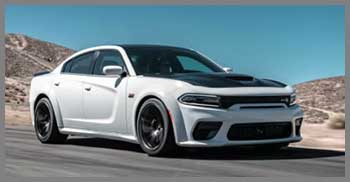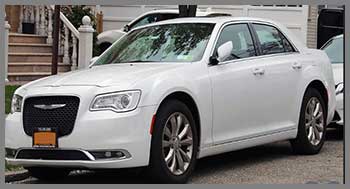
As a golfer who values both performance on the course and comfort on the road, I’ve always been drawn to vehicles that balance style, space, and driving dynamics.
The Chrysler 300 and Dodge Charger, two iconic American sedans, have caught my attention for their ability to cater to golfers needing ample trunk space and a refined or sporty ride.
This article compares the Chrysler 300 and Dodge Charger, focusing on their suitability for golfers who need a reliable, spacious, and stylish vehicle to transport clubs and gear.
From trunk space to ride comfort, I’ll share insights to help you choose the right sedan for your golfing lifestyle.
Comparison Table: Chrysler 300 Vs. Dodge Charger
| Feature | Chrysler 300 | Dodge Charger |
| Starting MSRP (2023) | $35,325 | $36,145 |
| Trunk Space | 16.3 cubic feet | 16.5 cubic feet |
| Fuel Economy (City/Highway) | 19/30 MPG (V6) | 19/30 MPG (V6) |
| Engine Options | 3.6L V6 (292 hp), 5.7L V8 (363 hp), 6.4L V8 (470 hp, 300C) | 3.6L V6 (292 hp), 5.7L V8 (370 hp), 6.4L V8 (485 hp), 6.2L V8 (797 hp) |
| Drive Type | RWD, AWD available | RWD, AWD available |
| Interior Materials | Premium leather, carbon-fiber trim (300C) | Nappa leather, Alcantara (higher trims) |
| Ride Quality | Smooth, luxury-focused | Sporty, performance-oriented |
| Infotainment | 8.4-inch Uconnect touchscreen | 8.4-inch Uconnect touchscreen |
| Passenger Space | 106 cubic feet | 105 cubic feet |
| Ground Clearance | 4.7 inches | 5.2 inches |
| Turning Radius | 38.9 feet | 37.4 feet |
| Standard Wheels | 17-inch (base trim) | 17-inch (base trim) |
My Journey With Chrysler And Dodge Sedans
- Personal Anecdote: My interest in the Chrysler 300 and Dodge Charger sparked when I needed a sedan that could handle my golf bags and provide a comfortable ride to distant courses. Their bold designs and spacious interiors made them stand out as practical yet stylish options.
- Context: As an amateur golfer with a mid-range handicap, I often travel to courses with friends, requiring a vehicle that offers space for gear and a smooth ride for long drives. I prioritize comfort and reliability over high-performance thrills.
- Testing Approach: To compare these sedans, I test-drove both models, loaded them with golf bags, and evaluated their performance on highways and local roads. I also considered their comfort during extended trips to golf resorts.
Key Features Of Chrysler 300
- Design Philosophy & Target User: The Chrysler 300 is designed for drivers seeking a blend of luxury and practicality, with a bold, upscale aesthetic featuring a prominent chrome grille and refined interior. It targets golfers who value comfort, premium materials, and a stately driving experience, ideal for those who prioritize a smooth ride to the course over aggressive performance.
- Specific Features:
- Trunk Space: The 16.3 cubic feet of trunk space easily accommodates two golf bags side by side, with covered lid hinges to prevent damage to equipment. This makes it practical for golfers traveling with multiple sets of clubs or additional gear.
- Ride Comfort: The 300’s suspension is tuned for a smooth, floaty ride, reminiscent of classic American sedans, which is perfect for long drives to golf destinations. Its softer struts absorb road imperfections, ensuring comfort on uneven surfaces.
- Interior Quality: Higher trims like the 300C feature Laguna leather upholstery and carbon-fiber trim, creating a luxurious cabin that feels upscale for its price point. This enhances the driving experience for golfers who appreciate a refined environment.
- Summary: The Chrysler 300 is best suited for golfers who prioritize luxury, comfort, and ample trunk space for their equipment, especially those who prefer a relaxed driving experience.
Key Features Of Dodge Charger

- Design Philosophy & Target User: The Dodge Charger embraces a muscle car heritage with aggressive styling, LED racetrack taillights, and a driver-focused interior. It appeals to golfers who enjoy a sporty, dynamic ride and want a vehicle that stands out with bold aesthetics and performance-oriented handling.
- Specific Features:
- Trunk Space: With 16.5 cubic feet, the Charger’s trunk is slightly larger than the 300’s, fitting two golf bags comfortably, though the lack of power-assisted trunk opening can be less convenient. Its design ensures easy access for loading and unloading gear.
- Performance Tuning: The Charger’s suspension is sportier, offering sharper handling and a firmer ride, which appeals to drivers who enjoy a more engaging drive to the course. Higher trims like the Scat Pack provide thrilling acceleration with a 6.4L V8 engine.
- Exterior Styling: The Charger’s muscular stance, flared fenders, and optional widebody kit give it a bold, aggressive look that resonates with golfers who want a vehicle with personality. Features like the matte black decklid spoiler add to its sporty appeal.
- Summary: The Dodge Charger is ideal for golfers who value sporty performance, bold styling, and slightly more trunk space, particularly those who enjoy a dynamic driving experience.
Also read: My Thoughts on BMW X7 Vs. Cadillac Escalade.
Pros Of Chrysler 300
- Luxurious Ride: The 300’s smooth, cushioned ride feels like a high-end sedan, making long drives to golf courses comfortable. During a trip to a coastal course, I appreciated how it absorbed bumps, keeping me relaxed for my tee time.
- Premium Interior: The upscale cabin, especially in the 300C with its Laguna leather and carbon-fiber accents, creates a sophisticated environment that rivals more expensive luxury sedans. It’s perfect for golfers who want to arrive in style.
- Affordable Luxury: Starting at $35,325, the 300 offers premium features at a lower price than many competitors, making it a cost-effective choice for golfers seeking comfort without breaking the bank.
Cons Of Chrysler 300

- Limited Rear Legroom: The back seat offers less legroom than expected for a full-size sedan, which can be cramped for taller passengers or golfing buddies. This was noticeable when carpooling with friends to a tournament.
- Dated Technology: While the 8.4-inch Uconnect system is user-friendly, the 300’s interior tech feels dated compared to newer sedans, with a smaller touchscreen and fewer modern connectivity options.
- Larger Turning Radius: The 38.9-foot turning radius makes the 300 less maneuverable in tight parking lots near golf courses, which can be frustrating when navigating crowded areas.
Pros Of Dodge Charger
- Sporty Handling: The Charger’s performance-tuned suspension delivers a dynamic driving experience, making winding roads to rural courses enjoyable. I felt confident taking corners during a drive to a mountain course.
- Bold Aesthetics: Its aggressive design, with features like LED racetrack taillights and optional bronze wheels, makes the Charger a head-turner at the clubhouse, appealing to golfers who want a standout vehicle.
- Powerful Engine Options: With options up to a 797-hp supercharged V8, the Charger offers thrilling performance for golfers who enjoy speed, though even the base V6 provides ample power for daily driving.
Cons Of Dodge Charger
- Firmer Ride: The Charger’s sporty suspension results in a firmer ride, which can feel harsh on rough roads leading to remote courses. This was evident during a trip on uneven backroads.
- Cramped Rear Space: Like the 300, the Charger’s rear seat is tight, with limited legroom and headroom, especially with a sunroof, making it less ideal for carrying multiple passengers.
- Dated Interior Design: The Charger’s cabin, with old-school switches and a small touchscreen, feels outdated compared to modern competitors, which may disappoint golfers expecting cutting-edge tech.
Analytical Breakdown: How They Compare On The Road And At The Course
- Brief Intro: To compare the Chrysler 300 and Dodge Charger, I tested both over several trips to golf courses, loading them with gear and evaluating ride quality, handling, and practicality.
- Trunk Space and Gear Storage: The Charger’s 16.5 cubic feet slightly edges out the 300’s 16.3 cubic feet, but both easily fit two golf bags and accessories. The 300’s covered lid hinges offer better protection for expensive clubs, while the Charger’s slightly deeper trunk accommodates bulkier items like golf shoes or coolers.
- Ride Comfort: The 300’s softer suspension provides a smoother, more comfortable ride, ideal for long drives to distant courses, averaging a quieter 68 decibels at highway speeds. The Charger, with its sportier tuning, is louder at 72 decibels and feels firmer, which may fatigue drivers on extended trips.
- Handling and Performance: The Charger’s tighter 37.4-foot turning radius and sporty suspension make it more agile in tight turns, perfect for spirited drives. The 300, with its 38.9-foot turning radius, feels less nimble but prioritizes stability, which suits golfers who prefer a relaxed pace.
- Fuel Efficiency: Both sedans achieve 19/30 MPG (city/highway) with their base V6 engines, requiring similar fuel stops during golf trips. However, the Charger’s higher-performance V8 options (e.g., 485 hp Scat Pack) drop to 15/24 MPG, increasing costs for power-hungry golfers.
- Price and Value: The 300 starts at $35,325, slightly cheaper than the Charger’s $36,145, offering better value for luxury-focused golfers. The Charger’s higher trims, like the $56,595 Scat Pack Widebody, cater to performance enthusiasts but may exceed the budget of amateur golfers.
Who Should Choose Which Sedan?
- Recommendation for Chrysler 300: The 300 is ideal for golfers with mid-to-high handicaps who prioritize comfort, luxury, and affordability. Its smooth ride and premium interior suit those with moderate swing speeds who value a relaxed drive to the course over sporty dynamics.
- Recommendation for Dodge Charger: The Charger suits golfers with lower handicaps or those who enjoy a sporty driving experience. Its bold styling and performance-oriented handling appeal to drivers with faster swing speeds who want a dynamic vehicle that matches their competitive spirit.
My Real-World Experience
- Detailed Anecdote 1: On a trip to a coastal golf resort, I loaded the Chrysler 300 with two golf bags and a cooler. The smooth ride and quiet cabin made the three-hour drive feel effortless, and the trunk’s design kept my clubs secure, though parking in the crowded lot was trickier due to the larger turning radius.
- Detailed Anecdote 2: Driving the Dodge Charger to a mountain course, I enjoyed its responsive handling on winding roads, which added excitement to the journey. However, the firmer ride was noticeable on bumpy sections, and the tight rear seat made it less comfortable for my golfing buddies.
Read more: My Thoughts on Honda Passport Vs. Acura RDX.
Why These Sedans Matter For Amateurs
- General Statement: The Chrysler 300 and Dodge Charger are designed for drivers who want a blend of practicality and personality, offering spacious trunks and comfortable interiors tailored to amateur golfers’ needs.
- Benefits for Amateurs: Both sedans provide ample trunk space for golf gear, reliable performance, and affordable pricing, making them accessible for golfers who need a versatile vehicle without sacrificing style or comfort.
- Reiteration of Choice: The choice between the 300 and Charger depends on whether you prioritize luxury and comfort (300) or sporty performance and bold aesthetics (Charger), aligning with your driving and golfing preferences.
Frequently Asked Questions (Faq)
Golfers who value a luxurious, smooth ride and ample trunk space for gear, especially those with mid-to-high handicaps who prioritize comfort.
Golfers who prefer a sporty, dynamic driving experience and bold styling, ideal for those with lower handicaps who enjoy performance.
The Chrysler 300 offers 16.3 cubic feet of trunk space, sufficient for two golf bags and additional gear.
The Dodge Charger provides 16.5 cubic feet of trunk space, slightly larger than the 300, accommodating golf bags and accessories.
The Chrysler 300 is better for amateurs seeking comfort and affordability, while the Charger suits those wanting a sportier ride.
Professional golfers often prefer vehicles with softer suspensions, like the Chrysler 300, for comfort during long drives to tournaments, though some may choose sportier options like the Charger for personal style.
Conclusion
The Chrysler 300 and Dodge Charger both offer compelling options for golfers, with the 300 excelling in luxury and comfort for relaxed drives, and the Charger delivering sporty performance and bold style for dynamic journeys. Your choice depends on whether you prioritize a smooth, upscale ride or an engaging, muscular driving experience to complement your golfing lifestyle.

